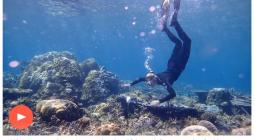Noise pollution is one of the gravest yet least recognized health threats of our time. Even moderate levels of noise – the kind that surrounds us in any urban environment – increase risks of cardiovascular disease, cognitive impairment, developmental delays and dementia. Now, scientists are revealing that non-humans, too, suffer from noise pollution – and that they are far more sensitive than humans.
Perhaps nowhere is this more urgent than in the global oceans. Marine animals see and sense the world through sound, which travels faster and farther underwater than light. Whales – which use sound to find prey and navigate, communicate and mate – are one well-known example. But scientists are now revealing that a vast range of marine creatures are exquisitely sensitive to sound. The range of negative effects caused by marine noise pollution is staggering: delayed development, hampered reproduction, stunted growth, distorted migration paths.
Extreme noise can kill outright. A single shot from a seismic survey air-gun can kill zooplankton – the foundation of the marine food chain – up to a mile away from the detonation site. Motorboat engine noise has been found to affect fish embryos. As one study grimly noted: human noise may even be scrambling the eggs of baby fish.
More remarkable still, even aquatic plants are highly sensitive to sound. Take, for example, marine seagrass. Just like terrestrial forests, seagrass is a carbon sink, contributing to stabilizing our global climate. Coasts were once abundant with seagrass meadows, which provide food and shelter for sea life, protect against erosion, enable nutrient cycling, stabilize the seafloor and filter pollutants. In the islands of the Pacific, seagrass meadows are both larder and pharmacy, hunting ground and healing space. The oldest known seagrass colony in the world (Posidoniaceae oceanica, off the Mediterranean coast of Ibiza) is over 100,000 years old, and quite possibly closer to 200,000 – which would make it the oldest living organism in the world.
In the past few decades, seagrass meadows the size of the Amazon have vanished. Climate change, pollution, boat anchors and dredging, the building of seawalls and harbors, and hypersaline water from desalinization plants are all likely factors. As researchers at the Technical University of Catalonia have recently discovered, we can now add noise pollution to this list of threats. When the scientists exposed a sample of Mediterranean seagrass to seismic blast-level sound, the seagrass was severely damaged, as were the symbiotic fungi that help the plants absorb nutrients.
Why would plants, without any apparent means of hearing, be sensitive to sound? Marine plants have organelles called amyloplasts, which help plants sense sound vibrations, and also store food, orient themselves to gravity and thus root themselves in the ocean floor. These tiny organelles are analogous to organelles found in octopuses and shrimp, called statocysts, which can sense even tiny sound vibrations in water. In octopuses, statocysts are grouped into lateral lines on their heads and arms. This explains how, even without ears, octopuses can locate prey or predators, particularly in low light conditions: they hear with their arms. Similarly, plants hear with their bodies.
Their sensitive hearing is an advantage in the dark depths of the ocean, but it makes aquatic organisms very vulnerable. Loud underwater sounds can damage or destroy their hearing ability. These effects occur at much lower intensities of sound than are known to be damaging to terrestrial animals. By way of analogy: imagine a loud siren passing by. Now imagine that it renders you deaf; disrupts your digestion; and renders you so dizzy that you are unable to walk or tell which way is up. This is the fate of marine organisms in an increasingly noisy ocean: an onslaught of noise that stunts, harms and even kills.
These findings underscore the vast threat that marine noise pollution poses to our oceans. As offshore operations – from seabed mining to oil and gas and renewable energy construction – are proliferating, little thought has been given to noise pollution. While exposure threshold levels have not yet been determined, it is clear that this emerging science will eventually lead to new restrictions on the permitting and operations of marine industrial and shipping activities.
-
Karen Bakker is the director of the University of British Columbia’s Program on Water Governance and the author of The Sounds of Life: How Digital Technology is Bringing Us Closer to the Worlds of Animals and Plants






